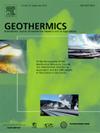利用多光谱卫星数据和云计算监测智利拉斯塔里亚火山地表热液矿床的应用和意义
IF 3.5
2区 工程技术
Q3 ENERGY & FUELS
引用次数: 0
摘要
热液蚀变的研究涉及火山环境中循环热侵蚀流体的影响,这对于理解火山灾害、斜坡不稳定性和蒸汽驱动爆炸至关重要。地表可见的热液沉积物提供了地下热液系统或火山动荡的直接证据,可以通过遥感工具检测到。本文介绍了热液沉积指数(HDI),这是一个基于多光谱卫星数据的超蓝、超红、SWIR 1和SWIR 2波段的遥感指数,可以对地表热液沉积进行时空分析。我们将人类发展指数方法应用于拉斯塔里亚火山,这是一座位于智利和阿根廷边境的层状火山,显示出剧烈的喷气孔活动。在谷歌地球引擎(GEE)的支持下,我们减轻了蒸汽羽流和雪等环境干扰,从而保证了结果的准确性。我们的HDI结果确定了Lastarria火山上的三个主要沉积带,面积约为600,000平方米,并通过独立的实地调查进行了验证。时间序列分析揭示了三种不同的HDI变化模式和峰顶火山口和侧翼区域热液活动的动态变化。此外,我们还证明了峰顶和侧翼的活动是连续发生的,并且HDI的增加与新的硫流的出现是一致的。该研究为火山遥感监测方法的发展做出了贡献,并强调了时空动态在灾害评估中的重要性。本文章由计算机程序翻译,如有差异,请以英文原文为准。
Applications and implications of monitoring surface hydrothermal deposits at Lastarria Volcano, Chile, using multispectral satellite data and cloud computing
Studies of hydrothermal alteration involve the effects of circulating hot and aggressive fluids in volcanic environments, which are crucial for understanding volcanic hazards, slope instability, and steam-driven explosions. Visible hydrothermal deposits at the surface provide direct evidence of subsurface hydrothermal systems or volcanic unrest and can be detected by remote sensing tools. Here, we introduce the Hydrothermal Deposit Index (HDI), a remote sensing-based index derived from the Ultra Blue, Red, SWIR 1, and SWIR 2 bands of multispectral satellite data that allows spatiotemporal analysis of surface hydrothermal deposits. We apply the HDI approach to Lastarria, a stratovolcano on the border between Chile and Argentina that shows vigorous fumarole activity. With the support of Google Earth Engine (GEE), we mitigate environmental interferences like steam plumes and snow, thereby guaranteeing the precision of findings. Our HDI results identify three main depositional zones on the Lastarria Volcano, covering approximately 600,000 m, and are validated against independent field surveys. Time series analysis reveals three distinct patterns of HDI variation and dynamic shifts in hydrothermal activity within the summit crater and flank regions. Furthermore, we demonstrate that activity at the summit and flanks occurs in succession and that an increase in HDI concurs with the appearance of new sulphur flows. This research contributes to the advancement of remote sensing methodologies for volcano monitoring and emphasizes the importance of spatiotemporal dynamics in hazard assessment.
求助全文
通过发布文献求助,成功后即可免费获取论文全文。
去求助
来源期刊

Geothermics
工程技术-地球科学综合
CiteScore
7.70
自引率
15.40%
发文量
237
审稿时长
4.5 months
期刊介绍:
Geothermics is an international journal devoted to the research and development of geothermal energy. The International Board of Editors of Geothermics, which comprises specialists in the various aspects of geothermal resources, exploration and development, guarantees the balanced, comprehensive view of scientific and technological developments in this promising energy field.
It promulgates the state of the art and science of geothermal energy, its exploration and exploitation through a regular exchange of information from all parts of the world. The journal publishes articles dealing with the theory, exploration techniques and all aspects of the utilization of geothermal resources. Geothermics serves as the scientific house, or exchange medium, through which the growing community of geothermal specialists can provide and receive information.
 求助内容:
求助内容: 应助结果提醒方式:
应助结果提醒方式:


